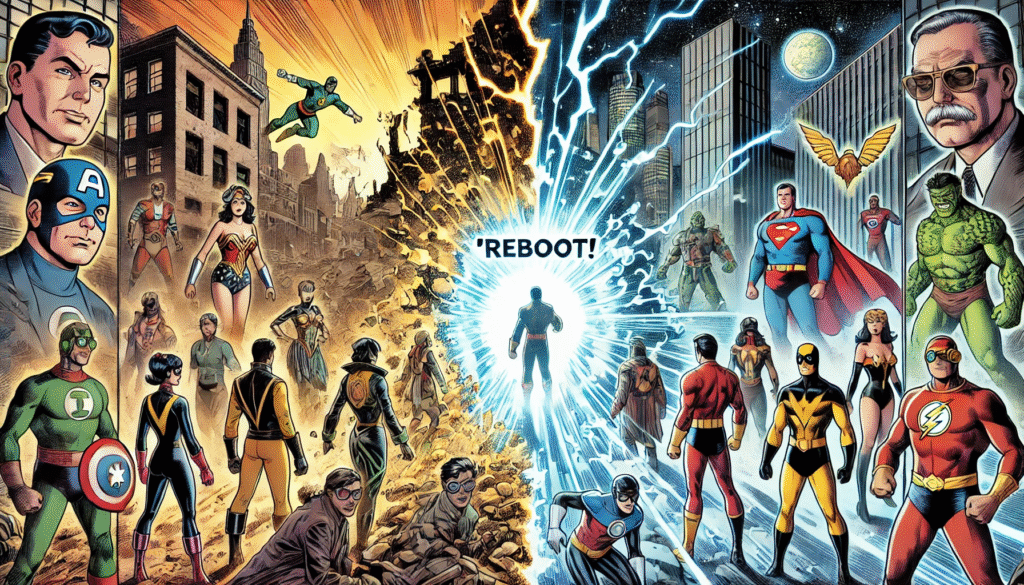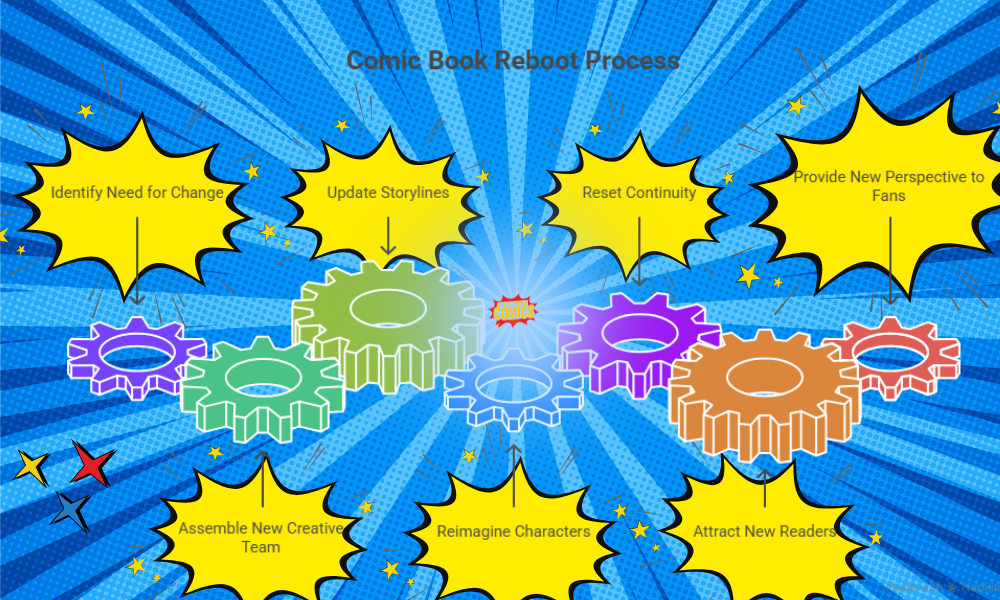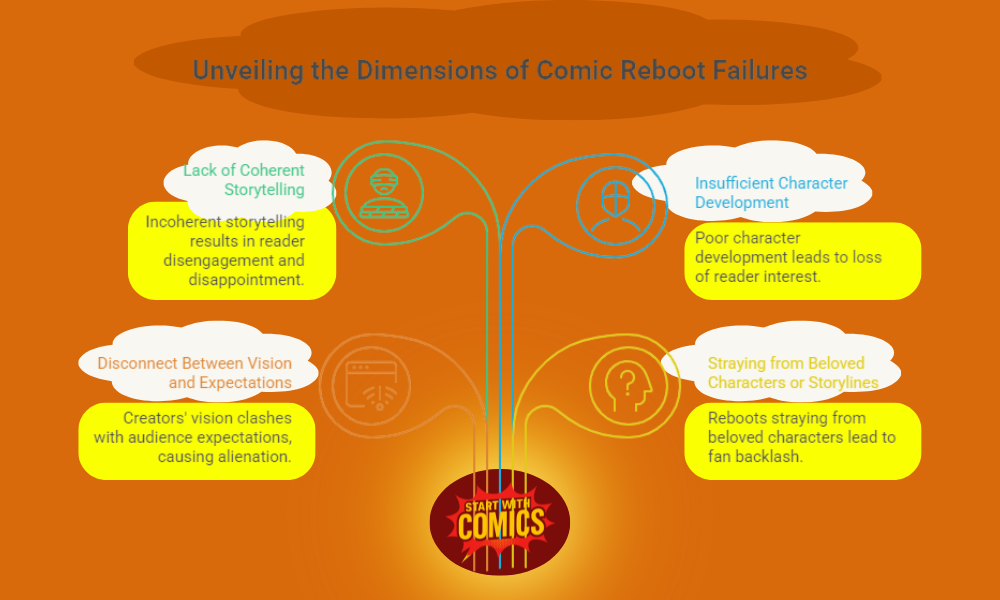
What Is a Reboot in Comics? Meaning, Examples & How They Work
Table of Contents
Table of Contents
Rebooting the Narrative
In today’s pop culture landscape, reboots are everywhere. Whether it’s your favorite superhero suddenly starting over, a beloved sci-fi show returning with a new cast, or a video game franchise resetting its storyline from scratch — the reboot has become a defining feature of modern storytelling.
But what exactly is a reboot?
At its core, a reboot is a creative decision to discard an established story’s previous continuity and start fresh. It’s not a sequel, prequel, or spin-off—it’s a reset. The old narrative is either erased or ignored, allowing creators to reimagine characters, timelines, and themes without being bound by what came before.
The term originates from computing, where to “reboot” a system means to shut it down and restart it—clearing out errors and giving it a clean slate. In fiction, the metaphor fits perfectly: a reboot wipes away complicated or outdated storytelling in order to build something streamlined, modern, and accessible.
Reboots are particularly common in comics, where decades of continuity can be both a rich legacy and a narrative burden. But they’ve also become a staple in film franchises (Batman Begins, Star Trek), TV series (Doctor Who, Battlestar Galactica), and even video games (Tomb Raider, God of War).
The result? New fans get a starting point. Old fans get a fresh take. And creators get room to experiment.
This article dives into what reboots are, why they happen, how they differ from other forms of adaptation, and which ones have made a lasting impact.

1. What Is a Reboot (Really)?
A reboot is the act of restarting a fictional universe or franchise by intentionally discarding all previous continuity. Unlike sequels or prequels—which build upon established lore—a reboot wipes the narrative slate clean, giving writers and artists the freedom to reinterpret characters, plots, and settings from the ground up.
Formal Definition:
A reboot is a narrative reset in which a creative property begins anew, with no obligation to adhere to the established history, canon, or character development of prior iterations.
This creative “restart” often retains familiar elements—like character names, costumes, or iconic settings—but reshapes their backstories, relationships, and motivations. It’s not just about changing the tone or art style—it’s about reimagining the foundation.
Software Metaphor:
The term “reboot” comes from the world of computing, where rebooting a system means turning it off and back on again to clear out errors or stalled processes. In storytelling, a reboot serves a similar purpose:
- Fix a broken or bloated continuity
- Introduce modern themes or values
- Regain creative control
- Streamline the universe for new audiences
Why Reboots Matter:
By wiping the narrative clean, reboots allow creators to:
- Fix problems in canon (contradictions, convoluted timelines)
- Modernize characters or settings for a new era
- Experiment without being limited by past versions
- Re-engage fans who may have drifted away due to complexity or fatigue
Examples of Story Reboots:
- Batman: Year One (1987) redefined Batman’s early years, replacing older Golden and Silver Age continuity.
- Ultimate Spider-Man (2000) gave Peter Parker a modern high school life, separate from the main Marvel universe.
- Star Trek (2009) created an alternate timeline so it could honor the original while charting new territory.
- Tomb Raider (2013) rebooted Lara Croft with a grittier, more realistic origin story.
Reboots, when done well, serve as both a clean start and a love letter to the source material—offering a way to revitalize aging franchises without losing their core identity.
2. How Reboots Differ from Remakes, Revivals, and Spin-Offs
In the world of media, terms like reboot, remake, revival, and spin-off are often used interchangeably—but they each serve very different narrative functions. Understanding these distinctions is key to recognizing what creators are trying to achieve and how it affects continuity.

Reboot
Definition: A full reset of a fictional universe. Previous continuity is discarded or ignored.
Goal: Reimagine the franchise from the ground up, often modernizing or streamlining it.
Continuity: Wiped clean—starts fresh.
Example:
- DC Comics’ The New 52 — Relaunched nearly every major character with new origin stories and histories.
- Spider-Man: Homecoming — A new Peter Parker in the Marvel Cinematic Universe, independent of previous films.
Remake
Definition: A retelling of an existing story, typically with new actors, updated visuals, or modern themes—but staying close to the original plot.
Goal: Present the same story in a contemporary package.
Continuity: Same story, different version.
Example:
- The Lion King (2019) — Same story and script as the 1994 animated classic, remade in photorealistic CGI.
- Psycho (1998) — A shot-for-shot remake of Hitchcock’s original.
Revival
Definition: A continuation of a long-dormant property, often bringing back original characters, actors, or storylines.
Goal: Extend or finish the original story for nostalgic or creative purposes.
Continuity: Same universe, picks up where it left off (sometimes years later).
Example:
- Star Wars: The Force Awakens — Revived the franchise with returning characters like Han Solo and Leia.
- X-Men ’97 — Picks up directly after the original 1990s animated series.
Spin-Off
Definition: A new story focusing on side characters or alternate perspectives from the original universe.
Goal: Expand the universe and explore fresh angles.
Continuity: Shares the same world and timeline.
Example:
- Better Call Saul — A character-focused prequel to Breaking Bad.
- Venom (2018) — A Spider-Man universe spin-off focusing on the antihero.
Why the Confusion Happens
These terms can blur together—for instance, a reboot can include familiar elements (characters, tone) like a remake, and revivals often feel like reboots when years have passed. The key difference lies in the treatment of continuity:
- Reboots = Wipe the slate.
- Remakes = Retell the same story.
- Revivals = Continue the story.
- Spin-offs = Branch out from the story.
This clarity helps fans manage expectations—and gives creators the right tools for reshaping beloved franchises.
3. Why Do Publishers Reboot Franchises?
Reboots aren’t random—they’re deliberate, strategic decisions made by publishers, studios, or creative teams. Whether it’s comics, movies, or TV, the goal is usually to revive, refresh, and reconnect with both old and new audiences.

Below are the key reasons reboots happen—and why they keep coming back.
1. To Refresh a Stale or Overcomplicated Franchise
Long-running series can become cluttered with decades of continuity, retcons, and contradicting character arcs. A reboot lets creators:
- Trim the narrative fat
- Clarify confusing backstories
- Reimagine core elements from a clean slate
Example:
DC Comics’ New 52 (2011) rebooted the entire universe with all-new #1s, streamlined histories, and modernized designs.
2. To Attract New Audiences
New readers or viewers often avoid long-running franchises because they don’t know where to start. Reboots lower that barrier by offering:
- Fresh entry points
- Updated cultural values
- Contemporary art, tone, and references
Example:
Star Trek (2009) introduced a new generation to the franchise by resetting the timeline, while still honoring the original.
3. To Capitalize on a Known Brand
Reboots are often safer commercial bets than original IPs. They offer:
- Built-in fan recognition
- Marketable characters
- Cross-platform synergy (merch, games, spin-offs)
Example:
The Amazing Spider-Man (2012) was a cinematic reboot following the Sam Raimi trilogy—aimed at relaunching the franchise for younger viewers and new licensing deals.
4. To Offer Creative Freedom
A reboot lets creators shed the “rules” of past continuity and try something new. This freedom allows for:
- Different tones or genres (e.g., noir, horror, satire)
- Unique visual aesthetics
- Reinvented relationships and motivations
Example:
Superior Spider-Man (2013)—Doctor Octopus takes over Peter Parker’s body, creating one of the most daring shifts in Spider-Man storytelling.
5. To Stay Culturally Relevant
Franchises must evolve with the times. A reboot can address:
- Shifting societal values (e.g., inclusion, representation)
- Outdated tropes or gender dynamics
- New storytelling platforms (like digital-first or webtoons)
Example:
Ms. Marvel (2014) introduced Kamala Khan in a reboot of the title, giving Marvel its first Muslim teen superhero as the lead.
Summary Table: Why Reboots Happen
| Motivation | What It Solves | Example |
| Refresh the Franchise | Convoluted lore and fatigue | DC’s New 52 |
| Attract New Audiences | Accessibility barriers | Star Trek (2009) |
| Financial Strategy | IP value, licensing, buzz | The Amazing Spider-Man (2012) |
| Creative Innovation | Need for narrative reinvention | Superior Spider-Man |
| Cultural Relevance | Updating tone and representation | Ms. Marvel (2014) |
4. Notable Reboot Examples and What Made Them Work
Not all reboots succeed—but the ones that do often strike the perfect balance between familiarity and reinvention. Let’s break down some of the most impactful reboots in comics, film, and TV—and why they resonated with both fans and newcomers.

Batman Begins (2005)
Medium: Film
What It Rebooted: The campy, colorful version of Batman from the late ’90s (Batman & Robin).
What Worked:
- Grounded tone, inspired by crime dramas
- Explored Bruce Wayne’s origin in depth
- Introduced a darker, more realistic Gotham
- Reinvigorated the franchise and launched the Nolan trilogy
Takeaway: A tonal reset and a focus on character depth can redefine a franchise.
Star Trek (2009)
Medium: Film
What It Rebooted: Classic Star Trek continuity
What Worked:
- Introduced an alternate timeline (“Kelvin Timeline”) to respect the original while starting fresh
- Younger, dynamic cast
- Action-heavy and visually modernized for new viewers
- Maintained key character dynamics
Takeaway: Using an in-story explanation (alternate timeline) helped merge old and new fans.
Mad Max: Fury Road (2015)
Medium: Film
What It Rebooted: The 1980s Mad Max trilogy
What Worked:
- Visual storytelling over heavy exposition
- No need for prior knowledge of the series
- Reintroduced the post-apocalyptic world with modern action and feminist themes
- Captivated critics and audiences alike
Takeaway: You don’t have to retell the origin—just deliver a fresh, bold vision.
DC’s The New 52 (2011)
Medium: Comics
What It Rebooted: Nearly all of DC’s superhero titles
What Worked:
- Every series restarted with issue #1
- Modern redesigns and updated origin stories
- Great jumping-on point for new readers
- Mixed success—some characters (like Batman) kept partial continuity
Takeaway: Line-wide reboots are bold but risky; execution and reader clarity are crucial.
X-Men: First Class (2011)
Medium: Film
What It Rebooted: The increasingly convoluted original X-Men movie timeline
What Worked:
- Set in the past, showing the origin of the team
- Fresh cast and character dynamics
- Laid groundwork for blending reboot with old continuity (Days of Future Past)
Takeaway: A reboot doesn’t always need to erase—sometimes it can revise or reframe.
Ultimate Spider-Man (2000)
Medium: Comics
What It Rebooted: Peter Parker’s origin and early years, separate from Marvel’s main continuity
What Worked:
- Modern setting, pacing, and tone
- Streamlined backstory without decades of baggage
- Introduced Miles Morales later as a legacy hero
- Widely considered one of the most successful reboots in comic history
Takeaway: Start fresh, but stay true to the emotional core of the character.
Key Traits of a Successful Reboot
| Trait | Why It Matters |
| Honors the core concept | Keeps the spirit of the original alive |
| Offers a clean entry point | Invites new audiences without confusion |
| Updates themes and tone | Makes the material relevant for modern times |
| Adds creative innovation | Prevents the reboot from feeling redundant |
| Balances nostalgia and change | Satisfies long-time fans and newcomers |
5. When Reboots Fail (and Why)
While some reboots breathe new life into a franchise, others crash and burn—often spectacularly. These failures usually stem from a lack of creative clarity, disrespect for the source material, or misguided attempts to cash in on nostalgia without offering substance. Here’s why reboots sometimes don’t work—and the cautionary lessons they provide.

Fan Backlash from Erasing Beloved Continuity
One of the biggest risks of rebooting a beloved property is alienating the fanbase. Long-time readers or viewers often feel emotionally invested in characters and storylines that have developed over years (or even decades). When a reboot wipes the slate clean with little care for what came before, it can feel like betrayal.
Why it fails:
- Long-time fans feel ignored or dismissed
- Emotional stakes are erased
- Characters become unrecognizable
Example:
DC’s New 52 rebooted nearly every character, but some fans were outraged by the erasure of key relationships (e.g. Lois and Clark) or changes to tone and history—particularly in books like Teen Titans or Green Lantern continuity inconsistencies.
Poor Creative Vision or Direction
A reboot needs a clear reason to exist. When the creative team doesn’t know why they’re rebooting—or if the vision is confused—the result is a muddled product that pleases no one.
Example:
Fantastic Four (2015) attempted a dark, “gritty” reboot of Marvel’s First Family. The tone clashed with the characters’ optimistic origins, and studio interference led to a fractured plot, poor pacing, and critical panning.
Key issues:
- Tonal dissonance
- Shallow character development
- Lack of cohesive story arc
- Doesn’t justify the reboot’s existence
Reboot Fatigue & Marketing Misfires
Audiences are smart. They can spot when a reboot exists more for business reasons than genuine creative intent. Overuse of the reboot formula can also create fatigue—especially when the new version doesn’t meaningfully improve or innovate.
Example:
The Mummy (2017) tried to launch Universal’s “Dark Universe” reboot of classic monsters. Despite big names like Tom Cruise, the film felt like a corporate product, more focused on world-building future spin-offs than telling a compelling story in the present.
Why it didn’t land:
- Over-marketed and underwritten
- Miscast lead
- Uninspired visuals and pacing
- No emotional or thematic core
Ignoring the Importance of Legacy
Rebooting doesn’t have to mean disrespecting the past. The most successful reboots honor the essence of what made the original resonate, even while introducing new ideas. When a reboot feels like it’s actively dismantling what fans loved, it can generate intense backlash.
Common sins:
- Dismissing fan-favorite characters
- Contradicting core values of the franchise
- Retconning beloved story arcs without payoff
Better approach:
Even when starting from scratch, successful reboots often include respectful nods to the original material—whether through easter eggs, spiritual successors, or thematic continuity.
Summary: Why Reboots Fail
| Reason | Example | Result |
| Erased Fan Legacy | DC’s New 52 (partial backlash) | Alienated loyal readers |
| Creative Confusion | Fantastic Four (2015) | Tonal mess, box office bomb |
| Corporate Overreach | The Mummy (2017) | Commercial failure, no momentum |
| Disrespect for Source | Various comic, film reboots | Loss of credibility, fan revolt |
F.A.Qs
What’s the difference between a reboot and a remake?
A remake retells the same story with modern updates. A reboot wipes the slate clean and reimagines the narrative from scratch, often with new backstories or settings.
Why are reboots so popular now?
Studios and publishers love reboots because they combine brand recognition with creative freedom. It’s easier to market a known property than a brand-new one—especially when you can repackage it for new audiences.
Can reboots still include elements of the original?
Absolutely. Some reboots feature returning actors (Star Trek 2009), similar plot arcs (Spider-Man: Homecoming), or Easter eggs that reward longtime fans—even if the core continuity is reset.
What makes a reboot fail?
The biggest pitfalls include
Ignoring the original’s emotional core
Poor storytelling or character changes without justification
Marketing fatigue (e.g., rebooting too often)
Lack of audience trust (Fantastic Four 2015 is a textbook case)
What is a “soft reboot”?
A soft reboot resets some elements while preserving others. Think X-Men: Days of Future Past—it cleaned up the timeline but didn’t erase everything. It’s a middle ground between sequel and total reboot.
Are reboots only for comics and movies?
Not at all. You’ll find reboots in TV shows, video games, and even novels. Anywhere a franchise ages or grows too complex, a reboot becomes a tool to simplify and reintroduce.
Final Thoughts :The Double-Edged Sword of Reboots
When executed with care, they can revitalize aging franchises, invite new fans, and reframe classic characters for a modern world. But when done poorly—without vision, respect, or storytelling depth—they risk erasing beloved lore, alienating long-time fans, and fading into cultural irrelevance.
The best reboots balance nostalgia and innovation. They don’t just restart a story—they reinterpret it, preserving the core spirit while evolving with new themes, audiences, and technologies.
Whether you’re diving into Ultimate Spider-Man, revisiting Batman Begins, or debating The New 52, the reboot question isn’t should it be done—but how.
